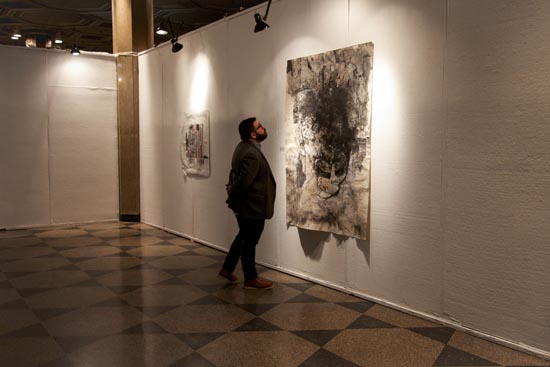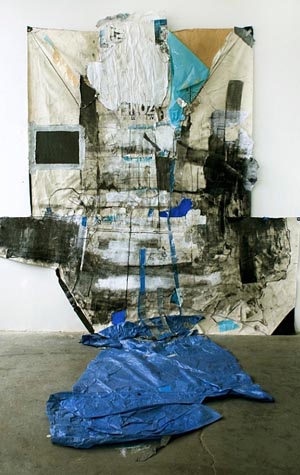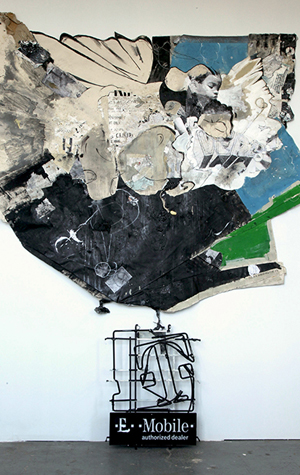“Challenging Painting as a Three-Dimensional Object”
BU's 808 Gallery showcases work of Cullen Washington, Jr.

Boogey Man is one of Washington’s earlier works. Photo by Nailya Maxyutova (COM’14)
In his recent works, abstract artist Cullen Washington, Jr., uses repurposed material to create collages, prints, and paintings that draw on his experience and heritage to explore a grander relationship with the unknown.
Titled Cullen Washington, Jr.: Land Before Words, a new show at the 808 Gallery focuses on this recent work, created over the past six years, and is a fascinating exploration of his continually evolving philosophy. Assembled from found objects, discarded materials, and studio floor scraps, the large-scale, irregular shaped pieces make a dramatic statement, with the largest extending upwards of 12 feet.
“Art is a conversation between me and the broadest of contexts—the universe, or god, or space, or whatever you want to call it,” says Louisiana native Washington, who earned an MFA at the School of the Museum of Fine Arts, Boston. “It’s a reflection of my thinking and how I metabolize the world.”
Washington’s earlier works confront issues of race through figurative representation. Many of these pieces rely on recognizable pop culture references to give them identity. Dyno-mite in My Room (2008) depicts Jimmy Walker, star of the 1970s sitcom Good Times.

“I was at a stage in my thinking where I wanted to represent the metaphor in the form of young black youth,” says Washington, who is African American, describing his earlier approach to art. These past works incorporate detritus, scraps, and found objects. “That was really exciting, to walk down the sidewalk and collect bits and pieces of society.”
The Final Frontier (2009) is characteristic of the monochromatic palette favored by Washington. The painting comprises a vast expanse of ebony, divided horizontally at the center by a cloudy white line. Approaching the border from the bottom left corner is the familiar form of the Starship Enterprise, moving towards that black expanse of space.
A transition in Washington’s artistic evolution can be seen in Blue (2012). The large-scale painted collage retains an element of science fiction, but here Washington takes a much more abstract approach. Large protrusions of canvas on each side suggest wings, and geometric patterns in the center suggest instrument panels—the piece is meant to represent a spaceship.
“When I was younger I had this model spaceship,” recalls Washington. “I was really into science as a kid, and this stuff is still coming out in the work I do.”
The painting is also an important marker of his progression as an artist. An attached blue tarp, which spills across the floor, not only punctuates the piece with color, but dominates the space much as a sculpture would.
“Painting is supposed to sit on a wall and not affect the area around it. I’m challenging painting as a three-dimensional object,” Washington says. To further the piece’s interaction with its surroundings, the top remains unattached to the wall, free to sway with the air currents.
The artist’s most recent works stray altogether from recognizable images or references toward an abstract utilization of lines, light, and scale. In Untitled #1 (2012), the chaos of collage is constrained within a linear order. The use of grids and irregular patterns is rendered in a palette ranging from cream to charcoal.

The work represents a shift in what show curator Lynne Cooney (GRS’08,’15), College of Fine Arts School of Visual Arts exhibitions director, calls Washington’s “formal approach towards the politics of representation.” It also coincides with a change in how he acquires and applies materials.
Washington was at a pivotal point after a Studio Museum artist residency last year, Cooney says, “where the works’ earlier reliance on readable iconography was giving way to almost total abstraction.” Recently, his “straightforward sense of materials is used to startling material effect. I wanted to use the scale of the 808 Gallery to highlight the structure and material of the work.” She says the time was “right to bring a selection of works from the past few years together—the first in Boston of this scale.”

“What happened was, I didn’t want to be dependent so much on the environment,” Washington says. “What I started to do is make work and then in a way deconstruct it, destroy it, and then reconstruct it again. It’s kind of like I’m using my own scraps.” In this way, process becomes equally fundamental to product in his work. “As I grew, I saw where my thinking had evolved or changed to where representation wasn’t a strong enough metaphor to communicate what I truly wanted to communicate.
“It’s nonrepresentational because the thing that I’m trying to communicate is transcendent and it represents all things and no things at the same time.”
Also at the 808 Gallery along with the Washington show is a group exhibition titled Lightning Speed of the Present. Using a variety of media and varying artistic approaches, the exhibition “considers the way in which the transient nature of experience—both individual and collective—is recorded, translated, interpreted, described, transcribed, and ultimately visualized through form and material,” says Cooney.
Cullen Washington Jr.: The Land Before Words is on view at the 808 Gallery, 808 Commonwealth Ave., through March 30. Gallery hours are Tuesday through Thursday, 11 a.m. to 5 p.m., Friday, 11 a.m. to 8 p.m., and Saturday and Sunday, 1 to 5 p.m. The exhibition is free and open to the public.
Paula Sokolska can be reached at ps5642@bu.edu.
Comments & Discussion
Boston University moderates comments to facilitate an informed, substantive, civil conversation. Abusive, profane, self-promotional, misleading, incoherent or off-topic comments will be rejected. Moderators are staffed during regular business hours (EST) and can only accept comments written in English. Statistics or facts must include a citation or a link to the citation.